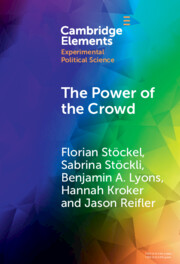Refine search
Actions for selected content:
245 results
Pharmacological interventions to manage cardiometabolic outcomes in adults with severe mental illness: umbrella review
-
- Journal:
- The British Journal of Psychiatry , FirstView
- Published online by Cambridge University Press:
- 04 December 2025, pp. 1-12
-
- Article
-
- You have access
- Open access
- HTML
- Export citation
Self-harm and suicide prevention in humanitarian and fragile contexts: A systematic scoping review
-
- Journal:
- Cambridge Prisms: Global Mental Health / Volume 12 / 2025
- Published online by Cambridge University Press:
- 04 December 2025, e145
-
- Article
-
- You have access
- Open access
- HTML
- Export citation
Distributional preferences in a global pandemic: Voter attitudes toward COVID-19 economic policy interventions
-
- Journal:
- European Journal of Political Research ,
- Published online by Cambridge University Press:
- 10 November 2025, pp. 1-28
-
- Article
-
- You have access
- Open access
- HTML
- Export citation
Chapter 19 - Psychosocial Approaches in CAMHS
-
-
- Book:
- Seminars in Child and Adolescent Psychiatry
- Published online:
- 10 October 2025
- Print publication:
- 30 October 2025, pp 296-312
-
- Chapter
- Export citation
Chapter 11 - Attachment, Anxiety Disorders and Experience of Trauma in Children and Adolescents
-
-
- Book:
- Seminars in Child and Adolescent Psychiatry
- Published online:
- 10 October 2025
- Print publication:
- 30 October 2025, pp 161-175
-
- Chapter
- Export citation
Behaviours that challenge in children with intellectual disability: systematic review and meta-analysis of pharmacological and non-pharmacological interventions
-
- Journal:
- BJPsych Open / Volume 11 / Issue 6 / November 2025
- Published online by Cambridge University Press:
- 27 October 2025, e256
-
- Article
-
- You have access
- Open access
- HTML
- Export citation
Integration of mental health and HIV service delivery in low- and middle-income countries: A systematic review of effectiveness
-
- Journal:
- Cambridge Prisms: Global Mental Health / Volume 12 / 2025
- Published online by Cambridge University Press:
- 09 October 2025, e112
-
- Article
-
- You have access
- Open access
- HTML
- Export citation

The Power of the Crowd
- How the Public Can Both Spoil and Improve Social Media as a Source of Information
-
- Published online:
- 07 October 2025
- Print publication:
- 06 November 2025
-
- Element
-
- You have access
- Open access
- HTML
- Export citation
Optimizing an evidence-based team-building intervention for dissemination: Collaboration Planning 2.0
-
- Journal:
- Journal of Clinical and Translational Science / Volume 9 / Issue 1 / 2025
- Published online by Cambridge University Press:
- 23 September 2025, e234
-
- Article
-
- You have access
- Open access
- HTML
- Export citation
Bibliometric Insights into Human Metapneumovirus Interventions: Trends, Gaps, and Future Directions
-
- Journal:
- Disaster Medicine and Public Health Preparedness / Volume 19 / 2025
- Published online by Cambridge University Press:
- 13 August 2025, e238
-
- Article
- Export citation
Learning from memes about ageism among Israeli Arab tweens
-
- Journal:
- Ageing & Society / Volume 45 / Issue 12 / December 2025
- Published online by Cambridge University Press:
- 30 July 2025, pp. 2602-2624
- Print publication:
- December 2025
-
- Article
-
- You have access
- Open access
- HTML
- Export citation
What was done for youths aged 15 to 24 around the world? A systematic review of worldwide mental health interventions
-
- Journal:
- Cambridge Prisms: Global Mental Health / Volume 12 / 2025
- Published online by Cambridge University Press:
- 24 July 2025, e97
-
- Article
-
- You have access
- Open access
- HTML
- Export citation
Chapter 7 - Maintenance Messages during a Health Emergency
- from Part II - Communicating during a Health Emergency
-
- Book:
- Risk Communication in Public Health Emergencies
- Published online:
- 05 June 2025
- Print publication:
- 19 June 2025, pp 164-200
-
- Chapter
- Export citation
A global scoping review of task shifting and sharing interventions to improve the mental health of people living with HIV/AIDS
-
- Journal:
- Cambridge Prisms: Global Mental Health / Volume 12 / 2025
- Published online by Cambridge University Press:
- 22 May 2025, e58
-
- Article
-
- You have access
- Open access
- HTML
- Export citation
Effectiveness of ATMAN psychological intervention in reducing self-harm in young people in India: a mixed method case series
-
- Journal:
- Cambridge Prisms: Global Mental Health / Volume 12 / 2025
- Published online by Cambridge University Press:
- 14 March 2025, e41
-
- Article
-
- You have access
- Open access
- HTML
- Export citation
22 - Moral Dimensions of Political Attitudes and Behavior
- from Part V - Applications and Extensions
-
-
- Book:
- The Cambridge Handbook of Moral Psychology
- Published online:
- 20 February 2025
- Print publication:
- 27 February 2025, pp 549-574
-
- Chapter
- Export citation
Measuring pro-environmental behavioural determinants using closed-answer surveys
-
- Journal:
- Oryx , First View
- Published online by Cambridge University Press:
- 23 January 2025, pp. 1-11
-
- Article
-
- You have access
- Open access
- HTML
- Export citation
9 - Conclusion
- from Part III - Implications for Academics and Policymakers
-
- Book:
- Local Peace, International Builders
- Published online:
- 02 January 2025
- Print publication:
- 16 January 2025, pp 177-186
-
- Chapter
-
- You have access
- Open access
- Export citation
1 - Introduction
- from Part I - Localized Peace Enforcement Theory
-
- Book:
- Local Peace, International Builders
- Published online:
- 02 January 2025
- Print publication:
- 16 January 2025, pp 3-21
-
- Chapter
-
- You have access
- Open access
- Export citation

Local Peace, International Builders
- How UN Peacekeeping Builds Peace from the Bottom Up
-
- Published online:
- 02 January 2025
- Print publication:
- 16 January 2025
-
- Book
-
- You have access
- Open access
- Export citation
